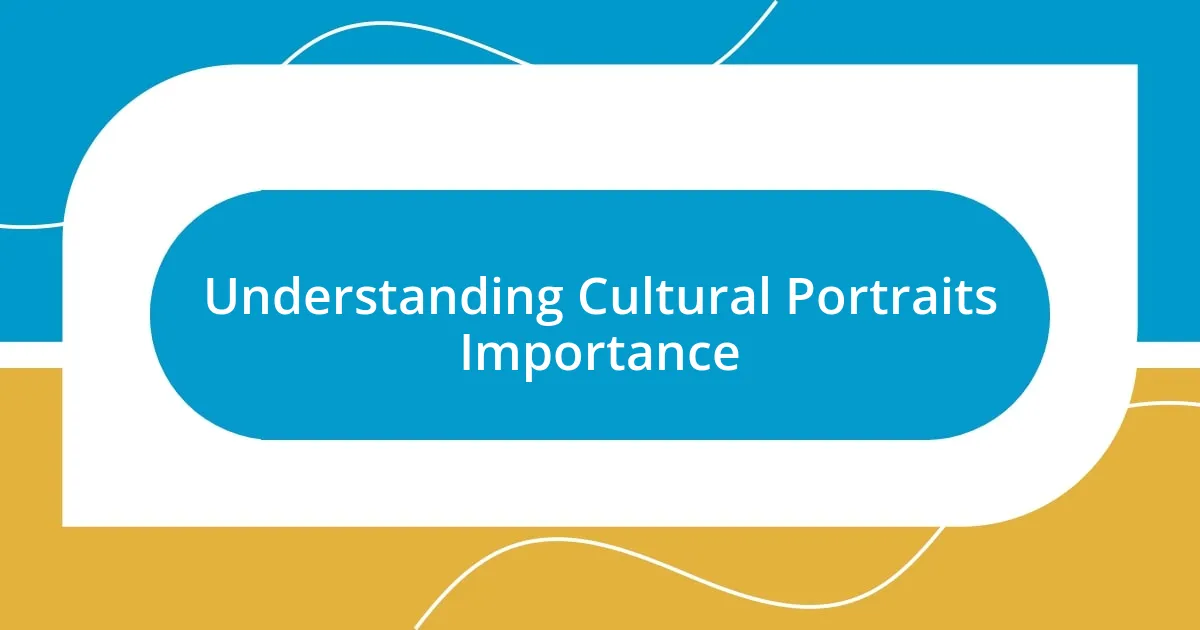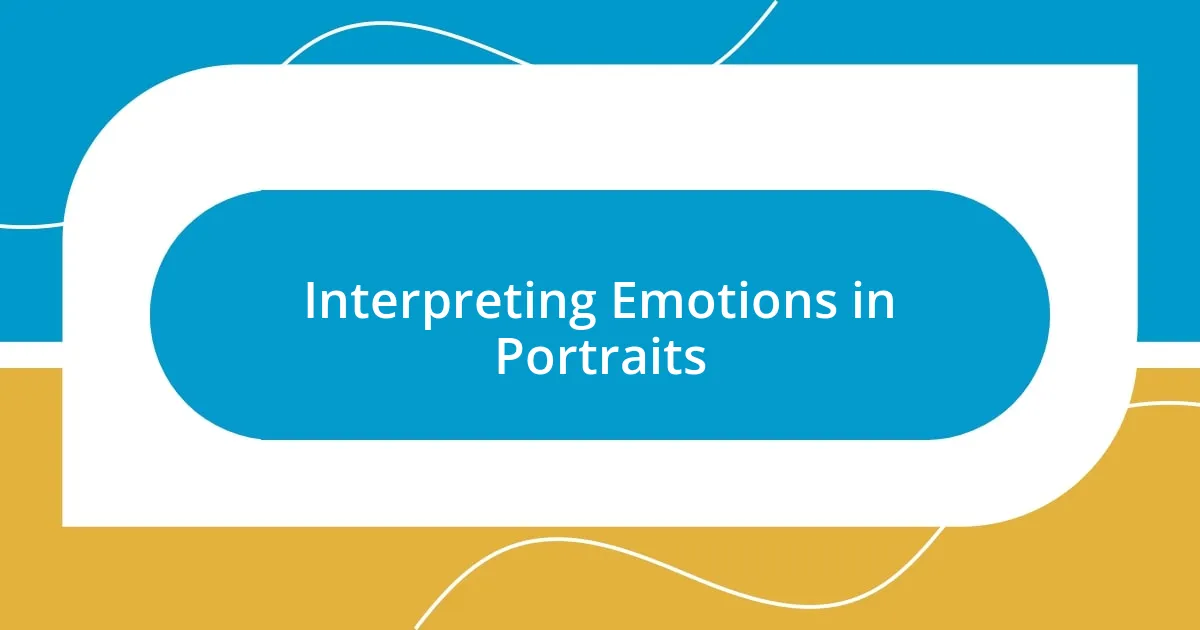Key takeaways:
- Cultural portraits capture and reflect the unique identity and traditions of communities, fostering understanding and compassion.
- Key elements include traditions, language, environment, artistic expression, and shared experiences, which together form a rich cultural narrative.
- Effective techniques for capturing culture involve immersive storytelling, photography, and participatory practices, enhancing connections with the culture.
- Ethics in cultural photography emphasizes respect, consent, and sensitivity towards subjects to avoid misrepresentation and ensure authentic storytelling.

Understanding Cultural Portraits Importance
Cultural portraits are essential because they capture the essence of a community’s identity. I remember attending a local festival where people shared their traditions through dance and storytelling; it struck me how these experiences painted vivid pictures of their heritage. Isn’t it fascinating how a single event can reveal so much about who we are?
In my travels, I’ve noticed that cultural portraits can bridge gaps between us. After meeting a family in a small village, their warmth and stories offered insights into their daily lives that removed barriers of misunderstanding. What if we all took the time to learn about each other’s backgrounds—wouldn’t we create a more harmonious world?
Understanding cultural portraits is not just an academic pursuit; it’s a deeply personal journey. I find that each story has the power to evoke compassion and connection, reminding us that we are all part of a larger human narrative. Have you ever felt that spark of recognition when learning about someone else’s experiences?

Key Elements of Cultural Portraits
Cultural portraits encompass several key elements that work together to reflect a community’s spirit. I’ve always been struck by how traditions, language, and environment intertwine to create a rich tapestry that tells a story. For instance, during a pottery workshop in a small town, I learned not just about the craft itself but about the historical significance behind each technique passed down through generations. It’s these unique stories that breathe life into cultural representations.
Here are some of the essential elements of cultural portraits:
- Traditions: Practices and rituals that define a group’s identity.
- Language: The words spoken and stories shared that encapsulate cultural nuances.
- Environment: The physical settings that shape and influence community lifestyles.
- Artistic Expression: Music, dance, and visual arts that showcase cultural creativity.
- Shared Experiences: Collective memories that foster a sense of belonging.
Exploring these aspects in depth allows us to appreciate the layers that form a vibrant cultural identity. Each conversation I have with someone from a different background reveals new facets that make our shared human experience undeniably rich.

Techniques for Capturing Culture
Capturing culture involves various techniques that can convey the depth and richness of a community’s identity. One method I find particularly effective is immersive storytelling, where I engage with locals, ask questions, and listen attentively. For example, during a visit to a vibrant cultural market, the vendors shared the history behind their crafts, prompting me to appreciate not just the product but also the stories they carried.
Photography is another powerful technique in capturing cultural nuances. I’d often snap pictures, not just of people, but of the spaces they inhabit—the bustling streets punctuated with colorful murals or the serene corners of a local park. Once, I captured a candid moment of a grandmother teaching her grandchild to weave; that single image transmitted a lifetime of tradition and mutual learning.
Finally, participating in cultural practices can provide firsthand insight into how individuals express their identity. I vividly recall learning a traditional dance in a community celebration; the experience didn’t just expose me to the steps but also immersed me in the joy, laughter, and rhythm of that moment. These techniques allow for a richer understanding and a more profound connection with the cultures I encounter.
| Technique | Description |
|---|---|
| Immersive Storytelling | Engaging with locals to uncover personal stories and insights. |
| Photography | Capturing visual elements that reflect the environment and community life. |
| Participatory Practices | Joining in cultural activities to deepen understanding and connection. |

Using Context in Cultural Portraits
Understanding the context in cultural portraits is vital; it’s the thread that weaves together individual narratives into a cohesive whole. Reflecting on my experience at a community festival, I was struck by how the backdrop of the event—the vibrant decorations, the sounds of laughter, and the smell of traditional foods—shaped the way I perceived the culture. It made me realize that environment isn’t just a setting; it’s an active participant in the storytelling process.
I often ask myself, how do our surroundings influence our cultural identity? During a documentary project in a secluded fishing village, I witnessed firsthand how the ocean dictated not only livelihoods but also community traditions. Conversations with local fishermen revealed their deep respect for the sea, which is often reflected in the songs they sing and the rituals they hold. This connection added incredible depth to my understanding of their culture, showing how context isn’t merely physical—it’s emotional and spiritual as well.
Context also extends to historical influences that shape a community’s beliefs and practices. I remember a conversation with an elder who shared accounts of significant events that molded their society, often accompanied by a heaviness in their tone. Such moments reminded me that a cultural portrait isn’t complete without acknowledging its history; it provides the lens through which today’s traditions and values are viewed. Engaging with these narratives deepens our appreciation and enriches our understanding of different cultures.

Interpreting Emotions in Portraits
When I look at portraits, the expressions often speak louder than words. I still remember the first time I gazed at a painting of an indigenous woman with piercing eyes and a subtle smile. It felt like she was inviting me into her world, sharing a depth of emotions that words could never convey. That moment taught me that a raised eyebrow or a slight downturn of the mouth can communicate thoughts and feelings that go beyond the surface.
Have you ever wondered how often we misinterpret emotions based on our own cultural lenses? For instance, while visiting a family in South Asia, I noticed that their laughter intertwined with sadness during a storytelling session. As they recounted tales of loss and resilience, I realized that their expressions told a complex story of joy and sorrow, reflecting the rich tapestry of their lives. This taught me that context plays a critical role; without understanding the background, we might miss the layers of meaning present in a single glance.
In my own journey, I’ve explored how colors and settings can amplify emotions in portraits. One time, during a visit to a rural community, I photographed a child sitting in a field of golden sunflowers, their expression a blend of curiosity and wonder. The vibrant yellow contrasted vividly with their deep brown eyes, creating a portrait that captured pure innocence. It reminded me that emotions can be beautifully intertwined with the environment, offering a fuller understanding of the subject. Each portrait is a canvas of feelings waiting to be interpreted—what stories do you think they hold?

Ethics in Cultural Photography
Ethics in cultural photography is deeply intertwined with respect and consent. I remember my trip to a remote village where I sought permission from community leaders before taking any photographs. This experience highlighted the importance of building trust; it’s essential to acknowledge the individual’s right to control how their image is shared and represented. Without this, we risk reinforcing stereotypes or misrepresenting their culture.
Moreover, cultural sensitivity plays a significant role in how we approach our subjects. One encounter I had was during a festival where, in my eagerness to capture the vibrant outfits, I inadvertently blurred the lines of personal space. A few community members expressed discomfort, teaching me that appreciating their culture should come with respecting their boundaries. It reminded me that sometimes, stepping back can be just as powerful as stepping forward with our cameras.
Finally, I often reflect on the implications of sharing cultural portraits on social media. While it’s tempting to showcase stunning images for the world to see, I’ve learned to question my motivations. Are we sharing authentic stories, or are we commodifying a culture for likes and shares? This introspection helps me stay true to the cultures I want to portray, ensuring that every image tells a story that values the subject, not just the viewer’s curiosity.

Sharing Cultural Portraits Effectively
Sharing cultural portraits effectively demands a delicate balance between storytelling and authenticity. I remember a vibrant community gathering where I decided to record individual narratives alongside my photographs. This choice transformed mere images into powerful stories. Each person’s voice added a layer of depth to their portrait, prompting me to think: how often do we listen to the stories our subjects want to tell before we push the shutter button?
It’s essential to consider the medium through which we share these portraits. I once experimented with printing a series of photographs along with the subjects’ own words at a local exhibit. The depth of understanding that emerged was staggering; people didn’t just see faces but felt the experiences behind each shot. It put into perspective how sharing context can create connections—what methods do you use to turn a simple image into an impactful narrative?
Lastly, I’ve found that engaging in dialogue with my audience is crucial. After sharing a cultural portrait on social media, I made it a practice to invite viewers to ask questions about the subject and their culture. This interactive approach not only fosters understanding but also encourages a respectful discussion that honors the individuals portrayed. In my experience, when we allow viewers to explore alongside us, we turn passive observation into active learning. How can we collectively broaden our perspective through shared conversations?












